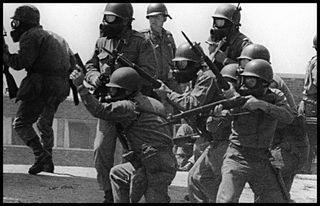Just last week, I noted the 40th anniversary of the Kent State killings, so it's strange that I am back writing about it again, so soon.
But this is kind of big.
There's much that we all know about Kent State. Students protesting Vietnam. National Guard presence on the campus. The retreat of the National Guard to the top of a hill. Then the sudden turn by the Guard and the opening up of gunfire on the students. 67 shots. Four dead in Ohio.
One question that remained somewhat a mystery over the years was whether the National Guard was ordered to fire, or whether (as they were later to claim at trial), they were responding to rocks or even gunfire directed at them.
Many pictures of the day exist, and they suggest that the National Guard was not acting in self-defense. (Also, many of the killed and wounded were more than a hundred feet away, which tends to suggest that the firing was not in response to an imposing threat).
But nothing conclusive.
Now, there is new evidence that all but ends the controversy. An audio recording of the shootings has been put through some modern-day technical analysis:
The Ohio National Guardsmen who fired on students and antiwar protesters at Kent State University on May 4, 1970 were given an order to prepare to shoot, according to a new analysis of a 40-year-old audio tape of the event.
"Guard!" says a male voice on the recording, which two forensic audio experts enhanced and evaluated at the request of The Plain Dealer. Several seconds pass. Then, "All right, prepare to fire!"
"Get down!" someone shouts urgently, presumably in the crowd. Finally, "Guard! . . . " followed two seconds later by a long, booming volley of gunshots. The entire spoken sequence lasts 17 seconds.
The previously undetected command could begin to explain the central mystery of the Kent State tragedy – why 28 Guardsmen pivoted in unison atop Blanket Hill, raised their rifles and pistols and fired 67 times, killing four students and wounding nine others in an act that galvanized sentiment against the Vietnam War.
The order indicates that the gunshots were not spontaneous, or in response to sniper fire, as some have suggested over the years.
"I think this is a major development," said Alan Canfora, one of the wounded, who located a copy of the tape in a library archive in 2007 and has urged that it be professionally reviewed. "There's been a grave injustice for 40 years because we lacked sufficient evidence to prove what we've known all along – that the Ohio National Guard was commanded to kill at Kent State on May 4, 1970."
***
The original 30-minute reel-to-reel tape was made by Terry Strubbe, a Kent State communications student in 1970 who turned on his recorder and put its microphone in his dorm window overlooking the campus Commons, hoping to document the protest unfolding below.
It is the only known recording to capture the events leading up to the shootings – including a tinny bullhorn announcement that students must leave "for your own safety," the pop of tear gas canisters and the wracking coughs of people in their path, the raucous protest chants, the drone of helicopters overhead, and the near-constant chiming of the campus victory bell to rally the demonstrators.
The enhancement of the audiotape is, of course, good news to the students who were there, and confirms what they have been saying for forty years:
"How do you spell bombshell?" said Barry Levine, whose girlfriend Allison Krause was mortally wounded as he tried to pull her behind cover. "That is obviously very significant. The photographic evidence and eyewitness accounts of what took place seemed to suggest everything happened in those last seconds in a coordinated way. This would be the icing on the cake, so to speak."
You can hear the recording here.
Pictured below: National Guard units approach the pagoda at the top of the hill. Allison Krause (who died that day) can be seen holding hands with Alan Canfora (mentioned in the article above) underneath the pagoda. The National Guard would go over the hill and down on a football practice field on the other side. Then they would return back to the hill, stopping at the pagoda, turn suddenly, and fire upon the students (see map below).
Killed (and approximate distance from the National Guard):
- Jeffrey Glenn Miller; 20, 265 ft (81 m) shot through the mouth – killed instantly
- Allison B. Krause; 19, 343 ft (105 m) fatal left chest wound – died later that day
- William Knox Schroeder; 19, 382 ft (116 m) fatal chest wound – died almost an hour later in hospital while waiting for surgery
- Sandra Lee Scheuer; 20, 390 ft (120 m) fatal neck wound – died a few minutes later from loss of blood
Wounded (and approximate distance from the National Guard):
- Joseph Lewis Jr. 71 ft (22 m); hit twice in the right abdomen and left lower leg
- John R. Cleary 110 ft (34 m); upper left chest wound
- Thomas Mark Grace 225 ft (69 m); struck in left ankle
- Alan Michael Canfora 225 ft (69 m); hit in his right wrist
- Dean R. Kahler 300 ft (91 m); back wound fracturing the vertebrae – permanently paralyzed from the chest down
- Douglas Alan Wrentmore 329 ft (100 m); hit in his right knee
- James Dennis Russell 375 ft (114 m); hit in his right thigh from a bullet and in the right forehead by birdshot – both wounds minor (died 2007)
- Robert Follis Stamps 495 ft (151 m); hit in his right buttock (died June 11, 2008)
- Donald Scott MacKenzie 750 ft (230 m); neck wound




